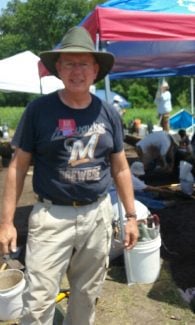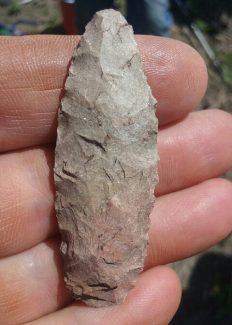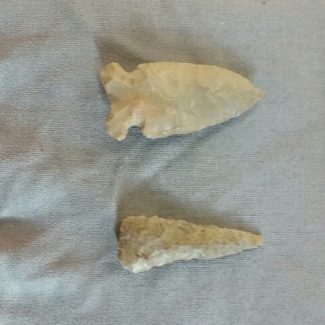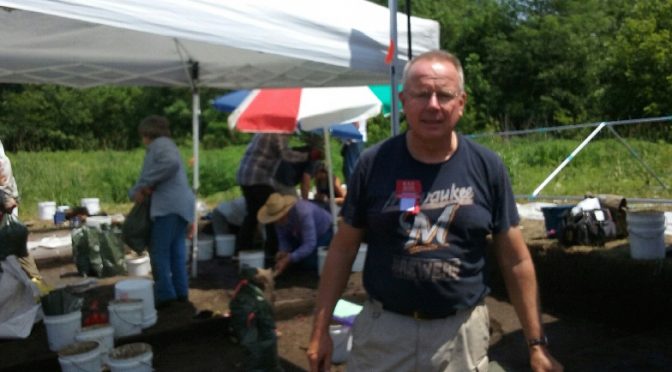Serving 27 years on the police force might have something to do with Newman University Director of Security Morris “Mo” Floyd’s passion for finding answers.
However, the kind of answers he recently spent two weeks searching for aren’t the kind that will help bring justice to local citizens. He was actually helping the Kansas Anthropological Association (KAA) find answers to the past. This year marks his eighth volunteering for the organization.
Discovering a Passion for Archeology
Floyd and his wife, Mary, took a vacation to James Madison’s house in Montpelier, Va. about nine years ago and witnessed nearby excavations taking place on some slave houses. The process had Floyd fascinated right away. After talking with some of the workers on the excavation site, Floyd was able to have a little more hands-on experience.
“The people doing the excavation let me hold artifacts and said I could sign up for a two-week stint without needing any experience,” Floyd said.

His interest had been piqued, but he knew it would be too far to travel in order to help at that particular site and he knew there was something to be said about helping out locally.
“The beauty of doing it locally is it’s our history, here in Kansas, things that pertain to us as a state and people,” he said.
After returning home, Floyd attended a talk at the Wichita Public Library’s Alford branch on South Meridian. The presenter was Donald Blakeslee, Ph.D., an archeological anthropologist and Wichita State University professor.
“He was doing a talk on projectile points in Kansas,” said Floyd. “When it was done, I asked if WSU ever used volunteers.”
Although Blakeslee’s answer wasn’t what Floyd wanted to hear, he did introduce him to the KAA where Floyd now spends many volunteer hours.
Volunteering with the KAA
Floyd started as a volunteer at the dig sites, but his participation with the organization has grown during his eight years there. He was recently contacted by the association’s previous 2nd Vice President Chris Hord — now the 1st Vice President — and asked if he would be interested in being an elected official.
The opportunity sounded very appealing to Floyd and he decided to run. This year is his first as an elected official and he said he enjoys the added involvement. His duties involve sending out public service announcement requests to all the state newspapers, acting as a member of the site selection committee and calling prospective candidates for other elected positions.
His efforts don’t stop there. Floyd is a trainer as well, teaching other volunteers how to do the work. “They put me in charge of a unit. Our units this year were two-meter by two-meter squares. They would assign one to me, they’d give me new people and I’d show them what to do.”
Floyd also said working at Newman University makes it even easier to be involved. “The university pays up to 48 hours of leave to volunteer in the community,” said Floyd. “So whenever I go to the sites, I wear my NU gear when I can, so I can represent the school.”
Floyd even arranged for the annual KAA meeting to take place on campus this year, bringing new faces who haven’t yet been able to see the university and its grounds.
Great Finds
Floyd said sites are chosen each year for different reasons. Archeologists with the Kanas Historical Society contact landowners across the state for permission to set up research-based digs on known sites.
“Things are divided into two types of sites — historical and prehistoric,” said Floyd. “The difference comes down to European contact. Prehistoric sites were occupied by Native Americans prior to Europeans introducing manufactured goods.”

“This month we were in Valley Falls, Kan. at a prehistoric site,” he said. “All we expected to find were stone tools, flint and pottery.”
What they ended up finding was much more than they expected, however. “We found arrow points, spear points, knife blades and we found a biface.”

Floyd explained that a biface is a tool that is sharp on both sides but may not be to its final stage of use and could eventually become a scraper, knife blade or smaller pieces made into arrow points. They also found some heads for an Atlatl — an Aztec word meaning “water thrower” — which is a Native American throwing stick, or spear thrower.
He said, “We found a lot of pottery this year which was really neat, some animal bone. We also found two fire pits, which was interesting.”
Floyd added, “It’s interesting that when I started this — you think of the classic arrowhead size and shape, that it is an arrowhead — but that isn’t an arrowhead, it’s a spear point.”
Floyd said the dig was successful. “We were able to disprove two things on this site: One, that there was strictly bow and arrow use, because we found spear points. And two, that this site was a possible housing site, and the evidence at the time we left points to a very temporary camp. None of the debris around the site would indicate long-term use in any way.”
Interesting Anecdotes
Floyd’s volunteer work has created some life-long memories for him to cherish. He talked about some of his experiences he’s had while working at the archeological sites.
“I’ve been to Hays, Kan. twice. The first time we did a dig associated with Billy Dixon who was famous for something he did during the Battle of Adobe Walls in Texas,” explained Floyd. “We thought it might be his store called Whiskey Ranch, but were unable to prove this.”
The second site was a Native American campground. “We found evidence that it was a transitional time in which the people there were going from using the Atlatl to bow and arrow. We were finding many different sizes (of arrowheads), and they hadn’t studied a site like that in years.”
Other favorite sites were John Brown’s cabin in Ossowatamie, Kan. where they found items correlated with the Civil War, and the Fool Chief’s Village site near Topeka, Kan.
During the time of the Valley Falls, Kan. dig, the volunteers and KAA members, along with local community members, were invited to participate in evening programs such as architectural tours, guest speaker presentations, and a “collector’s night” in which individuals brought in artifacts and presented their opinion on its date and what the item was.
“We ended the week with a project summary,” said Floyd. “They do a catered meal and then the primary archeologist will get up and say, ‘Here are the questions we started with and here are the answers we’ve found.'”
Floyd said if there are others who would like to get involved and volunteer, it’s easy to do. The KAA also has an individual that works with the Boy Scouts on the archeological merit badge. To find out more, contact Floyd at [email protected].


